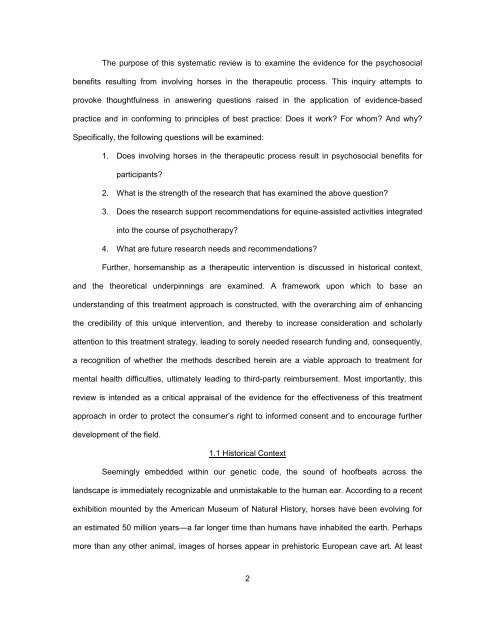A SYSTEMATIC REVIEW OF THE EFFECTS OF PSYCHOTHERAPY ...
A SYSTEMATIC REVIEW OF THE EFFECTS OF PSYCHOTHERAPY ...
A SYSTEMATIC REVIEW OF THE EFFECTS OF PSYCHOTHERAPY ...
You also want an ePaper? Increase the reach of your titles
YUMPU automatically turns print PDFs into web optimized ePapers that Google loves.
The purpose of this systematic review is to examine the evidence for the psychosocial<br />
benefits resulting from involving horses in the therapeutic process. This inquiry attempts to<br />
provoke thoughtfulness in answering questions raised in the application of evidence-based<br />
practice and in conforming to principles of best practice: Does it work? For whom? And why?<br />
Specifically, the following questions will be examined:<br />
1. Does involving horses in the therapeutic process result in psychosocial benefits for<br />
participants?<br />
2. What is the strength of the research that has examined the above question?<br />
3. Does the research support recommendations for equine-assisted activities integrated<br />
into the course of psychotherapy?<br />
4. What are future research needs and recommendations?<br />
Further, horsemanship as a therapeutic intervention is discussed in historical context,<br />
and the theoretical underpinnings are examined. A framework upon which to base an<br />
understanding of this treatment approach is constructed, with the overarching aim of enhancing<br />
the credibility of this unique intervention, and thereby to increase consideration and scholarly<br />
attention to this treatment strategy, leading to sorely needed research funding and, consequently,<br />
a recognition of whether the methods described herein are a viable approach to treatment for<br />
mental health difficulties, ultimately leading to third-party reimbursement. Most importantly, this<br />
review is intended as a critical appraisal of the evidence for the effectiveness of this treatment<br />
approach in order to protect the consumer’s right to informed consent and to encourage further<br />
development of the field.<br />
1.1 Historical Context<br />
Seemingly embedded within our genetic code, the sound of hoofbeats across the<br />
landscape is immediately recognizable and unmistakable to the human ear. According to a recent<br />
exhibition mounted by the American Museum of Natural History, horses have been evolving for<br />
an estimated 50 million years—a far longer time than humans have inhabited the earth. Perhaps<br />
more than any other animal, images of horses appear in prehistoric European cave art. At least<br />
2
















